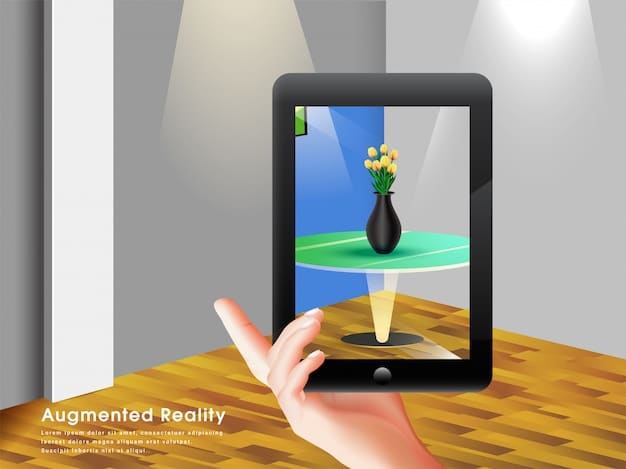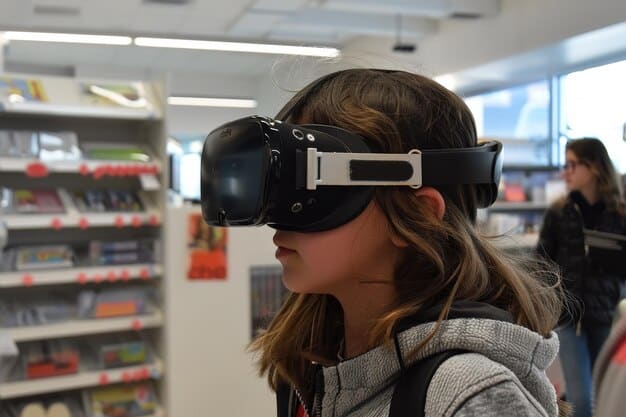Augmented Reality: How US Businesses Enhance Customer Experiences

Augmented Reality (AR) applications are transforming how US businesses engage with customers by creating immersive and interactive experiences, enhancing product visualization, and providing real-time support and information.
Augmented Reality (AR) applications: How US Businesses Are Using AR to Enhance Customer Experiences are rapidly changing the landscape of customer interaction. By blending digital content with the real world, businesses in the US are finding innovative ways to provide memorable and impactful experiences, ultimately driving customer satisfaction and loyalty.
Understanding Augmented Reality Applications in the US Market
Augmented reality (AR) has moved beyond futuristic concepts to become a practical tool for businesses across various sectors. In the US market, AR applications are reshaping how companies interact with their customers, offering unique and engaging experiences.
From retail to healthcare, AR is providing innovative solutions. This transformative technology promises to increase customer engagement, enhance brand loyalty, and drive sales. To fully appreciate its impact, let’s first dive into the core concepts of augmented reality.
The Basics of Augmented Reality
AR enhances the real world by overlaying digital information onto it. Unlike virtual reality (VR), which creates entirely simulated environments, AR integrates digital elements into the user’s actual surroundings. This is typically achieved through smartphones, tablets, or specialized AR glasses.
The technology works by using sensors and cameras to detect the environment. Once the device recognizes its surroundings, it can then project digital content, such as images, videos, or 3D models, onto the real-world view.
Key Components of an AR System
An AR system consists of several essential components:
- Tracking Technology: This allows the AR system to understand its position and orientation in the real world. Common methods include GPS, accelerometers, and computer vision.
- Display Technology: Smartphones and tablets are common displays, but dedicated AR headsets like Microsoft HoloLens provide more immersive experiences.
- Sensors and Cameras: Cameras capture the real-world environment, while sensors collect data to help the system understand its surroundings.
- Software: This includes AR development platforms like ARKit (for iOS) and ARCore (for Android) that allow developers to create AR experiences.
AR benefits businesses by generating innovative customer experiences. This introduction provides a base for understanding the upcoming topics.
Revolutionizing Retail Experiences with AR
The retail sector has been one of the earliest and most enthusiastic adopters of AR technology. By integrating AR into the shopping experience, retailers are creating more engaging and informative ways for customers to interact with products. This has led to increased sales and improved customer satisfaction.
From virtual try-ons to interactive product demos, AR is transforming how consumers discover and purchase items.

Virtual Try-Ons and Product Visualization
One of the most popular applications in retail is the virtual try-on. AR apps allow customers to see how clothing, accessories, or makeup would look on them without physically trying the items on. This is particularly useful for online shopping, where customers cannot physically interact with the products.
For example, eyewear retailers like Warby Parker offer AR apps that allow customers to virtually try on different glasses frames using their smartphone cameras. This reduces the uncertainty associated with purchasing online and increases the likelihood of a sale.
Interactive Product Demonstrations
AR can also be used to create interactive product demonstrations. Customers can use their smartphones or tablets to scan a product and view an animated overlay that explains its features and benefits. This is particularly useful for complex products like electronics or appliances.
IKEA, for instance, has an AR app that allows customers to virtually place furniture in their homes to see how it would look before making a purchase. This helps customers visualize the product in their own environment and reduces returns.
Examples of AR in Retail:
- Sephora Virtual Artist: Allows customers to virtually try on makeup products.
- Nike Fit: Scans the customer’s feet to determine the perfect shoe size.
- Gap DressingRoom: Lets customers virtually try on clothes using an avatar.
AR’s transformative impact on retail is visible in these examples. The technology provides engaging and interactive experiences that drive sales and improve customer satisfaction.
AR in Healthcare: Enhancing Patient Care and Training
The healthcare industry is also leveraging the power of AR to improve patient care, enhance medical training, and streamline processes. AR applications in healthcare range from surgical planning to patient education, demonstrating the technology’s wide-ranging potential within the medical field.
AR technology offers a method to improve different facets of care, including patient outcomes and medical professional training.
Surgical Planning and Visualization
AR is being used to create 3D visualizations of a patient’s anatomy based on medical imaging data. Surgeons can use these visualizations to plan complex procedures and practice their techniques before entering the operating room. This can lead to more precise surgeries and better patient outcomes.
Companies like Augmedics have developed AR headsets that allow surgeons to view a patient’s internal anatomy in real-time during surgery. This provides surgeons with a “superpower,” allowing them to see through skin and tissue to identify critical structures.
Patient Education and Engagement
AR can also be used to educate patients about their conditions and treatment options. By overlaying digital information onto anatomical models, healthcare providers can explain complex medical concepts in a more engaging and understandable way. This can help patients make informed decisions about their care.
For example, a physical therapy app could use AR to guide patients through exercises, ensuring they are performing them correctly. This can improve adherence to treatment plans and accelerate recovery.
Use Cases for AR in Healthcare:
- AccuVein: Projects a map of veins onto a patient’s skin, making it easier to find veins for injections or IVs.
- Medivis: Provides surgeons with real-time holographic visualizations of a patient’s anatomy during surgery.
- Osso VR: Offers virtual reality surgical training modules for medical residents.
AR is transforming healthcare, improving surgical precision and patient education and engagement. These advances result in better care.
Manufacturing and Industrial Applications of AR
In the manufacturing and industrial sectors, AR applications are streamlining processes, improving efficiency, and enhancing worker training. From assembly line support to remote maintenance assistance, AR is proving to be a valuable tool for improving productivity and reducing costs.
With the implementation of AR, manufacturing processes can be enhanced substantially regarding efficiency and precision.
Assembly and Maintenance Assistance
AR can provide workers with step-by-step instructions overlaid onto their view of the assembly line or equipment. This can help them perform tasks more quickly and accurately, reducing errors and improving throughput. AR ensures compliance and reduces errors.
For example, Boeing has used AR to guide workers through the complex process of assembling aircraft wiring harnesses. By projecting instructions onto the physical components, AR has reduced assembly time and improved quality.
Remote Expert Guidance
AR enables remote experts to provide real-time guidance to workers in the field. Using AR headsets or mobile devices, experts can see what the worker sees and provide instructions or annotations directly onto their view. This is particularly useful for troubleshooting complex problems or performing maintenance on equipment in remote locations.
Companies like PTC offer AR platforms that enable remote assistance. This can reduce downtime and travel costs, and improve the speed and effectiveness of problem resolution.
AR benefits in Manufacturing:
- Increased Efficiency: Providing real-time instructions speeds up processes.
- Reduced Errors: Overlaying information directly onto the task reduces mistakes.
- Improved Training: AR accelerates learning with hands-on, guided experiences.
AR has substantial benefits for manufacturing and industrial applications. Efficiencies rise, and productivity soars.
Marketing and Advertising: Engaging Customers with AR
Marketing and advertising are also seeing significant changes thanks to AR technology. Brands are using AR to create more engaging and memorable experiences for consumers, helping them stand out in a crowded marketplace.
AR campaigns provide consumers with new methods of interacting with products and brands.

Interactive Advertising Campaigns
AR can transform static advertisements into interactive experiences. By scanning a print ad or product packaging with their smartphone, consumers can unlock additional content, such as videos, animations, or 3D models. This can create a more engaging and memorable experience than traditional advertising.
For example, Pepsi has used AR to create interactive bus shelters that transform into simulated alien invasions or tiger attacks. This creates a buzz and encourages consumers to share their experiences on social media.
Augmented Reality Games and Contests
Brands are also using AR to create games and contests that encourage consumers to interact with their products. These AR experiences can be used to promote brand awareness, generate leads, or drive sales. Games and contests drive engagement.
McDonald’s has run AR promotions that allow customers to scan their Happy Meal boxes to unlock AR games and experiences. This encourages repeat purchases and drives foot traffic to their restaurants.
AR Marketing Strategies:
- Interactive Print Ads: Scan to unlock additional content.
- AR Games: Engaging experiences to promote brand awareness.
- Virtual Product Demos: Allowing consumers to see products in their own environment.
AR significantly impacts marketing and advertising by providing fresh and captivating consumer experiences.
Challenges and Future Trends in AR Applications
While AR offers numerous benefits for US businesses, there are also challenges to overcome. Issues such as technology limitations, cost, and user adoption must be addressed in order to achieve the full potential of AR.
Future trends, such as advancements in hardware, software, and connectivity, will continue to shape the development and adoption of AR applications.
Overcoming Technical Limitations
One of the main challenges is the technical limitations of current AR devices. Issues such as battery life, processing power, and display quality can limit the user experience. Additionally, AR applications require robust internet connectivity and reliable tracking technology, which can be challenging in some environments.
Manufacturers are working to improve these limitations by developing more efficient hardware and software. As technology advances, these problems will become less significant.
Addressing Cost and Complexity
Developing and deploying AR applications can be costly and complex. Businesses need to invest in specialized hardware, software, and development expertise. Additionally, creating engaging and effective AR experiences requires careful planning and design. A critical component to consider.
To address these challenges, businesses can leverage AR development platforms and partner with experienced AR developers. This can help reduce costs and complexity, and ensure that AR projects are successful.
Future Trends in AR
- Advancements in Hardware: Lighter, more powerful AR glasses with better display quality.
- Improved Software: More intuitive and user-friendly AR development platforms.
- 5G Connectivity: Faster, more reliable connectivity for seamless AR experiences.
While challenges exist, the future of AR is promising. Advancements in hardware, software, and connectivity will provide more advanced and user-friendly AR experiences.
| Key Point | Brief Description |
|---|---|
| 📱 Virtual Try-Ons | Customers can virtually try products, boosting online sales. |
| 🩺 Healthcare Training | AR improves surgical planning and patient education outcomes. |
| 🏭 Industrial Efficiency | AR streamlines assembly and maintenance tasks in manufacturing. |
| 📣 Interactive Ads | AR transforms advertising into engaging consumer experiences. |
Frequently Asked Questions (FAQ)
▼
AR enhances the real-world view with digital overlays, while VR creates fully immersive, simulated environments. AR blends digital content with the real world; VR replaces it entirely. This distinction leads to varied applications across industries.
▼
AR enhances the customer experience by enabling virtual try-ons, interactive product demos, and personalized shopping recommendations. This results in increased customer engagement, better-informed purchase decisions, and higher satisfaction rates, ultimately driving sales.
▼
AR in healthcare is primarily used for surgical planning, patient education, and training. It provides surgeons with real-time visualizations, helps patients understand their conditions better, and enhances the training of medical professionals. These applications benefit both patients and providers.
▼
AR is used in manufacturing and industrial settings for assembly assistance, maintenance guidance, and remote support. It provides workers with real-time instructions, reduces errors, and enhances productivity, leading to more efficient operations and cost savings.
▼
Businesses face challenges such as technical limitations, high costs, and complexity when implementing AR. Overcoming issues of battery life, processing power, and the need for specialized expertise is crucial for successful AR deployments. Careful planning is necessary.
Conclusion
Augmented Reality (AR) applications are revolutionizing various industries by enhancing customer experiences, streamlining processes, and creating new opportunities for engagement. As technology continues to evolve, US businesses that embrace AR will be well-positioned to thrive in an increasingly competitive market.